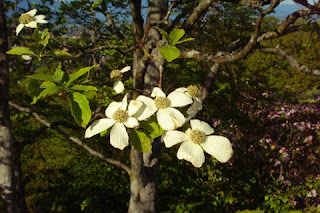One Sunday recently I went to Van Dusen Gardens to see the cherry blossoms. It was one of our first really mild days so I made it a day for my first picnic of the year too. Not too many of the flower beds were blooming, but there were many blossoming trees and shrubs which made it a pleasant, picturesque walk.
These lovely gardens, located at 37th and Oak Street in the city and easily accessible by public transit, have been developed on property that once belonged to the Canadian Pacific Railway and later leased by the Shaughnessy Golf Club from 1911 - 1960 when the golf club moved to a new location. The CPR wanted to subdivide but this was opposed and in 1966 Van Dusen Botanical Garden Association was formed to assist the Vancouver Park Board with developing the site. The development started in 1971 and was officially opened to the public August 30, l975.
The garden covers 22 hectares (55 acres) and is a spectacular collection of plants from around the world representing ecosystems from tropical South Africa to the Himalayas, South America, the Mediterranean and plants native to the Pacific Northwest and other parts of North America. No matter what season you, there's always something beautiful to see.
At this time of year, cherry blossom time, I specifically wanted to visit because every year in Vancouver they hold a Japanese haiku poetry contest. Van Dusen Gardens has many Japanese cherry trees and there is a stone engraved with some of the haiku that people have written about the trees.
One of the very first haiku I can remember reading was one by Basho, and it got me interested in the haiku verse form.
"This day on which the cherry blossom fell has drawn to its close." The translated forms of haiku, written in English are usually three lines of 5 syllables, 7 syllables, 5 syllables, although the American version varies to sometimes shorter lines. The haiku is usually about nature and the finally line will leave a lasting visual impression.
I enjoyed strolling around the pathways of the Gardens, discovering new shrubbery in bloom and even some sculptures.
Even though it was still early in the season, there were many flowers in bloom as well as the shrubbery and trees.
Rhododendron blossoms
The garden design has displays of plants in picturesque settings, to illustrate botanical relationships such as the Rhododendron Walk. The gardens are set amidst rolling lawns, small lakes and rock work.
There are some areas that represent specific origins such as the Sino Himalayan Garden, and this beautiful pavilion honoring the Koreans.
There's always something interesting to see at Van Dusen, no matter what the season! It's open seven days a week. There's a restaurant on the site if you want to stop for a meal. Or why not take along a picnic lunch like I did?
For Admissions and other information:
www.vandusengarden.org

































